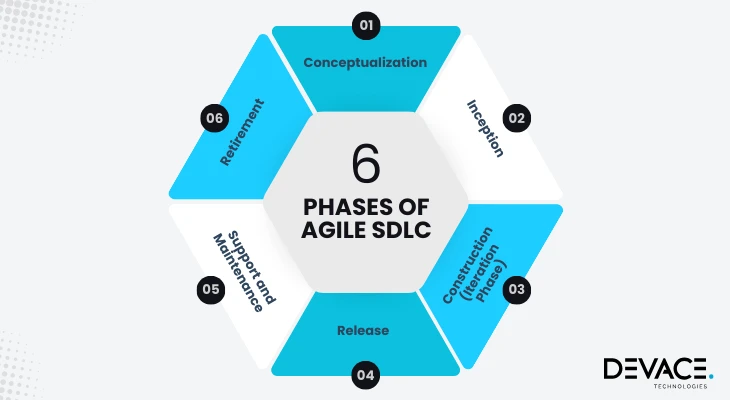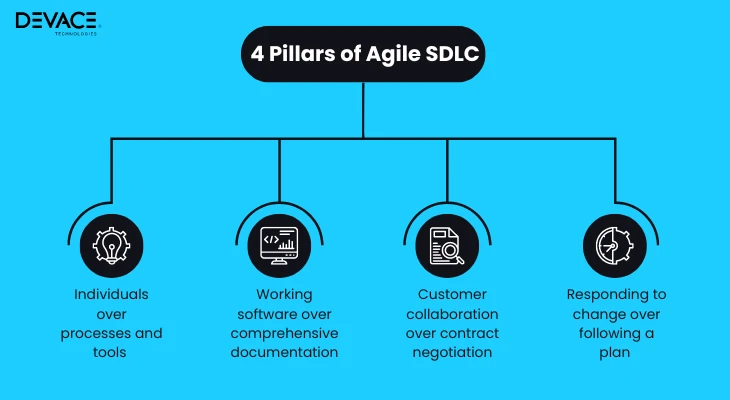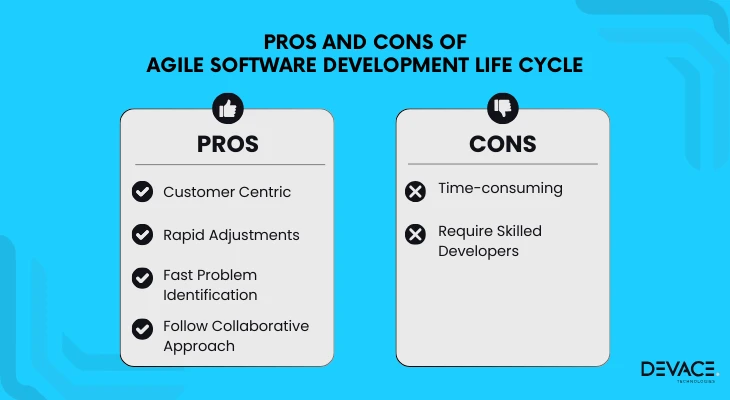Traditional software development seems to be a reasonable approach but in the fast-paced development nowadays it has become difficult to go with. Contrary software development approaches like agile software development lifecycle and relevant models that come under it have won the race.
In this blog, we focus on agile software development, phases of agile SDLC, pillars, and its advantages and disadvantages.
What is Agile Software Development Life Cycle (SDLC)?
The agile software development life cycle is an iterative approach that delivers projects in small chunks also known as sprints instead of providing projects in one time. The team breaks the larger project into smaller cycles or sprints followed by an iterative approach to see if there is any need for improvement.
To understand better, let’s take an example of it – so, for instance, in the first sprint the team may focus on creating strategy and design, in the next step the team develops the prototype, and in the third and fourth sprints, a complete fully-functional product is development.
What are the 6 phases of the Agile software development life cycle?
The six phases of Agile SDLC start from conceptualization, inception, construction, release, support and maintenance, and finally retirement.

Let’s take a look at the above-mentioned six phases in detail.
1. Conceptualization
This is the first phase of agile software development in which the project scope is determined. In case there is more than one project then the prioritization is based on putting projects first which are the most critical ones.
In this phase, the product owner and client discuss the requirements for the project. After that, a document is prepared which is known as Project Requirements Document (PRD) in which the goals are set. In this document, the goals, time, costs, and other important project details are also discussed.
An in-depth analysis at this stage is required for the progressive start of software development. In this phase, developers can prioritize the critical aspects of software and add the others in later stages.
2. Inception
Once the preliminary detail of the project gets finalized, the product owners start to work on the resource allocation. In this phase of the agile software development life cycle, the product owner checks the availability of the team which includes designers and developers.
After forming the team, the design process starts creating mockups, workflows, Unified Modeling Language (UML) diagrams, and project architecture. The design team does all the important work to understand the visual and critical functionalities, their working, and how they will work in the existing framework.
On this page, the business development team also gives a few check-ins to ensure that the inception phase of the project stays on track.
3. Construction (Iteration Phase)
This is the third and most important phase of the agile methodology in which most of the work happens. This phase is also known as the iteration phase in which the UI/UX and the engineering team collaborate to create the product that can go for testing when ready. The developers must write the code of design created by the UX team. It also includes creating functionalities before the sprint ends so that an application is ready to be displayed to the client. Other essentials like security features and remaining functionalities can be added in other sprints.
4. Release
In this phase, the product is almost completed and ready to launch. However, before releasing the product and making it available to users, it is essential to test the product thoroughly. QA testers perform rigorous methods to ensure there are no bugs or errors, and the product/web app solution runs smoothly.
In case the bugs are found, QA testers report to them so that they can fix them. This phase also includes user training, the creation of the system, and user documentation to support it. Once testing and user training are completed, the product is ready to be pushed to the live stage and released into production.
5. Support and Maintenance
After the application is available to the end users, the dev team is available to provide continuous support and maintenance in case support or maintenance is needed. This phase solves the post-launch queries and also incorporates feedback to plan the features and upgrades.
6. Retirement
Every product has a shelf life, and the product can be retired for different reasons including replacement with a new product with better features and functionalities or not enough users due to some poor market demand or experience. In this phase, the developers provide support to upgrade your product or retire it entirely from the market depending upon the requirements.
What are the 4 pillars of Agile SDLC?
In the Agile Manifesto, document focuses on the four pillars and twelve principles that set the basis for the agile software development lifecycle.

Let’s take a look at them briefly.
1. Individuals over processes and tools
The first pillar of agile entrusts individuals rather than heavily relying on the processes and tools for the outcomes. It focuses on teamwork, collaboration, and teamwork to get the desired results by putting your trust in their expertise, skills, and commitment to the project.
2. Working software over comprehensive documentation
The agile software development lifecycle approach focuses on delivering the software as quickly as possible. It says that instead of prioritizing lengthy documentation and knowledgebase, the focus must be on completing the software development and sending it over to users hands so they can use it and give feedback for iteration.
3. Customer collaboration over contract negotiation
The agile software development approach understands the emergent nature of the project in which the clients require may emerge or change. It says one should not get bound to the contract negotiations but rather offer a more collaborative approach. It yields customer trust and loyalty, making them returning customers.
4. Responding to change over following a plan
The nature of the agile software development life cycle is known for its flexibility in contrast to traditional software development. For this very reason, the agile approach adapts to the changing strategy if the needs come to achieve better results. Therefore, instead of rigidly following a set plan, Agile teams are encouraged to pivot and adjust based on new information, feedback, or market changes, making them more responsive to dynamic environments.
Pros and Cons of Agile SDLC
Before you get confused about which one is better in Agile vs Waterfall methodology for project management, let’s take a look at the pros and cons of Agile SDLC which are discussed below.

Benefits of Agile Software Development LifeCycle
The benefits of an agile SDLC include versatility, a customer-centric approach, quick problem detection, and a collaborative approach.
Customer Centric
Agile SDLC is entirely custom-centric as its pillars and principles focus on creating the product according to the client’s requirements not what YOU think is right. Agile methodology results in regular discussions, focus group analysis, and feedback that assists in developing successful products.
Rapid Adjustments
Agile software development lifecycle (SDLC) understands the emergent nature of the project and market. You can pivot your product based on customer preferences, audience behavior, and changing market trends. For example, if you identify in a phase that this feature is not the right fit and it needs to be better – you can easily pivot it around the custom needs, unlike traditional project management approaches.
Fast Problem Identification
The traditional management approach is rigid as it does not work in sprints and the project cannot be dissembled for a few reasons. However, with an agile development life cycle, the teams work in sprints, and they can roll back easily if any obstacle occurs. Therefore, one of the main advantages of agile methodology is quick problem identification and rectification.
Follow Collaborative Approach
The agile life cycle welcomes feedback at every sprint and follows a collaborative approach that gives time for improvement. The working teams are accountable for every process and part of the work they do; therefore, the teams collaborate to ensure that the project keeps moving successfully.
Drawbacks of the Agile Software Development LifeCycle
Even though the agile software development lifecycle offers many advantages like everything it has its drawbacks as well.
Time-consuming
The agile development approach is fast and time-consuming as it requires regular check-ins, frequent meetings, feedback, scrum meetings, and constant communication. Therefore, developers have to spend time in meetings as well as the development process which makes developers swamped with less time on hand.
Require Skilled Developers
Working in an agile environment requires skilled developers, UI/UX designers, quality assurance engineers, and project managers so that they can handle the fast-paced nature. If you have freshers who have never worked in an agile process, it might get a bit tiring and exhausting for them which can impact project development progress.
Agile Software Development Methodologies
Agile software development methodologies include Scrum, Kanban, Extreme Programming (XP), and Lean Development.
-
Scrum
It is one of the most popular agile software development methodologies in which the sprints are highly focused. Teams who utilize Scrum model do a 15-minute Scrum meeting at the start of the day to get the progress and track of the project.
-
Kanban
Kanabn originated from the Japanese language which means ‘just in time’. In this model of Agile life cycle methodology, there is a Kanban board in which the columns are made. There is a card for each task and the columns show the processes in the development process. This gives a clear overview of the working capacity and progress of the team. It is typically used by HR and marketing departments.
-
Extreme Programming (XP)
It is a highly collaborative Agile methodology that emphasizes frequent releases, constant customer feedback, and adaptability. It encourages practices like pair programming, continuous integration, and test-driven development to ensure high-quality software and rapid response to changing requirements.
-
Learn Development
Lean Development focuses on maximizing value while minimizing waste in the software development process. It draws inspiration from Lean manufacturing principles, emphasizing efficient workflows, faster delivery, and continuous improvement, ensuring that every step in development adds value to the customer.
Conclusion
Agile methodology is an effective project management approach that prioritizes customer satisfaction. Software development companies are rapidly adopting the agile development approach for project management to complete the projects in sprints and optimize the product in sprints taking a whole lot of time to make adjustments.
If you want to leave siloed working behind, then leave the traditional software development methodologies and utilize agile software development lifecycle.
Launch Your Project Successfully with Devace Technologies
Are you looking for a software development company that follows an agile development approach to complete your project successfully?
At Devace Technologies, we follow a robust project management approach powered by feedback, frequent check-ins, and communication.
Hire developers today and become agile!
Frequently Asked Questions
Is the Agile development lifecycle better than Waterfall?
In agile vs waterfall methodology, Agile takes the first place. Agile is often considered more adaptable than Waterfall because it allows teams to make adjustments as they go. Unlike Waterfall’s rigid, step-by-step approach, Agile embraces flexibility and constant feedback, making it ideal for projects with evolving requirements. However, if your project has clear, fixed steps from start to finish, Waterfall might be more straightforward.
What is the story lifecycle in Agile?
In Agile, the story lifecycle begins when a feature is described from a user’s perspective—this is called a user story. These stories are then prioritized in the backlog. During each sprint, teams break the stories into tasks, develop and test them, gather feedback, and refine the feature. The cycle continues until the feature is ready for deployment.
How long does Agile development take?
Agile development is split into short cycles called sprints, which usually last 1-4 weeks. While sprints are fast paced, the total time for a project can vary depending on its scope and complexity. Teams focus on delivering working features in each sprint, so even though Agile is iterative, the project could take several weeks or months.
What are the five stages of Agile development?
The five stages of Agile development are concept, inception, iteration, release, and maintenance. It starts with planning and conceptualizing the project, then moving to iteration, where teams continuously develop and test features. After that, the project is released, and teams shift to maintaining and improving the software based on user feedback.
